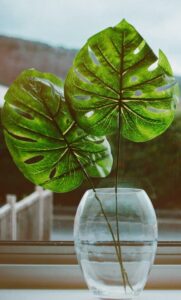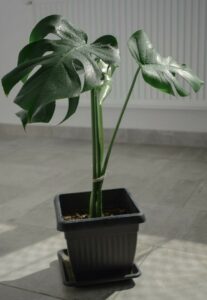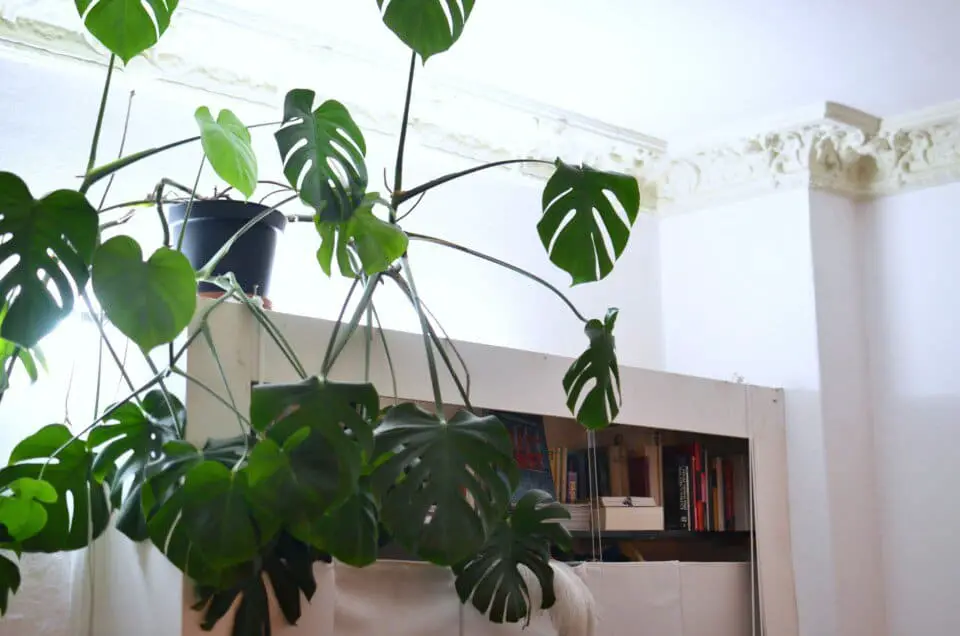Some links in the post are affiliate links and I get a commission from purchases made through some links found in the post.
When it comes to Monsteras, most people have tried to grow one from seed, but what if you could just leave the plant in water for a long time?
Even though water propagation is widely discussed, what would happen if you left your Monstera in water for an extended period?
You can definitely grow a monstera in water and for some time, but it will never reach its full size and health potential. A Monstera that is left in water will be able to survive, but it will not thrive.
Monstera Deliciosa can grow in water if the following conditions are met. You fertilize it with a hydroponic fertilizer, change the water frequently, and clean the roots thoroughly.
My conclusion is that the plant should be moved to the soil after studying the differences between growing plants in water vs. planting them in the ground.
When it comes to the health of my only Monstera, I don’t think I’d want to put it in the hands of a watery environment. A Monstera can be successfully grown in water, but there are a few things to keep in mind before you start.
Can you Grow Monstera in Water Only?
 As said before to grow a monstera in water only, you will need to make sure you fertilize it with a hydroponic fertilizer, change the water frequently, and clean the roots thoroughly.
As said before to grow a monstera in water only, you will need to make sure you fertilize it with a hydroponic fertilizer, change the water frequently, and clean the roots thoroughly.
Aside from those conditions I’ve outlined, I think it looks fantastic. Clear vases can also be used in a novel way with this arrangement.
People who use Leca in their semi-hydroponic systems need to flush them every few weeks, so they drill a hole in the vase’s side to allow for drainage.
Putting Monstera in Water
If you’ve decided to keep your Monstera in water after considering all the above pros and cons.
Clean your Plant First
Using your fingers, loosen the soil around the plant’s roots after removing it from its pot. After that, It’s as simple as giving it a gentle scrub in the sink.
Alternatively, you can use a soft brush to remove any remaining potting soil. Roots should be completely free of dirt at the end of this exercise.
Apply fungicide to any roots that appear brown or black. Sterilized pruning scissors can be used to remove any brown or black roots.
To keep your scissors germ-free, soak them in 70-90 percent rubbing alcohol. Apply a fungicide afterward to prevent re-infection. In the absence of root-rot cases, we recommend using it.
Put your Plant in Water for the Third Time
Fill your jar halfway with water, then submerge your plant. To keep the plant upright, choose a large and long container.
At no time should any leaves come in contact with the water. They will begin to rot if they don’t.
How to Care for a Monstera in Water Only
Clean the Roots Properly
Aside from the fact that I’m not the most patient with myself, I’m getting better at this. This happens when you transplant a plant from the soil to the water (or leca).
Root rot can occur if too much soil is left on the plant’s roots, preventing oxygen from reaching the roots.
Increase Light, Temperature, and Humidity
If you ever change your plant’s environment, follow this advice.
You can give your plant the extra energy it needs to resist shock by increasing light, temperature, and humidity. To that end, take care not to overheat or burn your plant.
Do not expose it to direct sunlight or temperatures exceeding 28C/82F.
Use the Right Fertilizer
Since your plant won’t be receiving nutrients from the soil, you’ll need one explicitly designed for hydroponics. I use General Hydroponics as previously stated.
If you’re keeping many plants in water, you may want to invest in a pH test kit. Your plant’s ability to absorb nutrients may be compromised if the pH is off.
If you only plan to keep your Monstera in water, you may not need to worry about this. Monstera is known for being easy going. I’ve only used fish poop as a fertilizer.
How Long can you Grow a Monstera in Water?
Monsteras are one of my favorite plants to propagate in water. The mother plant usually responds well to a haircut, and cuttings take no time to grow roots in water (provided all the proper steps are followed).
Since they grow so fast, Monstera cuttings are perfect plants to give away to friends or even sell as starter plants. They are also one of the easiest large houseplants that you can grow.
Monstera propagation is nothing to be afraid of; it’s one of the best beginner plants to learn how to grow cuttings in water.
- We usually recommend waiting at least 2-3 months to ensure a solid root system has formed for a better chance of survival. However, a Monstera can live in water for many months (if not years) as long as you change the water regularly, clean the roots and move the cutting into a bigger jar as it grows.
- Providing your new houseplant with adequate water is essential to its upkeep. If you over-water your plant, you may end up with root rot or fungal growth; if you are under-watering, you may end up with dried-out leaves. On the other hand, Monsteras are forgiving plants, so let’s review some watering fundamentals for this lovely one.
When watering your Monstera, the simple answer is that they don’t like to be too wet or too dry. They prefer it when the soil is between these two extremes.
What Water do I Need to Use?
 Light, nutrients, water, and carbon dioxide are necessary for plants to thrive. Soil isn’t required as long as you can feed them.
Light, nutrients, water, and carbon dioxide are necessary for plants to thrive. Soil isn’t required as long as you can feed them.
Hydroponic farming, which does not use soil, has become increasingly popular. Even LECA, an inorganic medium, can be used for semi-hydroponics.
That doesn’t mean putting the plants in water and then placing them in bright direct sunlight. It doesn’t end there, though.
Keep the water aerated by feeding it with nutrients and oxygen. In fact, because they have easier access to nutrients, these plants will grow even faster.
Hydroponics allows you to develop any type of plant. Water alone won’t suffice. Add a complete fertilizer, such as Dyna-Gro Grow, to ensure a healthy lawn and garden.
Hydroponics, soil watering, and foliar feeding are all possible uses for this fertilizer. Non-recirculating hydroponic systems should use 1 teaspoon of Dyna-Gro Grow per gallon of water, according to the label.
You should add 2-3 teaspoons per gallon to your water if you have an advanced system that circulates it.
Plants such as Monstera are hardy enough to tolerate water from a standard faucet. Since chlorine, fluorine, or salt content is not excessive.
The excess chlorine can be dissipated by allowing the water to stand in an open container overnight. If possible, you should use filtered or rainwater, as they don’t contain excess salts that may alter pH.
Remember that these plants do best in pH between 5.5 and 6.5. (5.5 to 7.0).
Pros of Growing a Monstera in Water Only
Imagine watching the roots of your Monstera grow in a vase of water. It appears to have an enchanting beauty.
1) It’s Cheaper Over Time
Making potting soil from scratch isn’t necessary. Even with an expensive RO unit, water is significantly less costly.
2) Growing Plants in Water Reduces Pests
This is another reason why hydroponics is appealing to me.
Some pests (like gnats, which lay their eggs in the soil and feed on the decaying matter) can be reduced to almost zero by growing plants in water.
However, thrips and spider mites (which I’m currently fighting – some plants have both) are less effective with this product. Treating plants for pests is easier as long as they are in the water.
You don’t have to be concerned about making a mess or wasting soil when you use the showerhead on your hose to blast them.
3) You Can Check the Roots Really Easily
Take the plant out and inspect it if you don’t have clear plant containers. Once your plant has been moved from the soil to the water, be on the lookout for root rot and cut it off immediately.
If you do it right, it can be low-maintenance, or you can use an aquarium to grow your Monstera.
4) It is Less Messy
You won’t have to deal with soil when repotting or making a plant mix. Additionally, pets known to dig won’t cause havoc in your home.
5) Deals with Monstera Underwater or Overwatering
You don’t have to worry about overwatering or underwatering your Monstera when you water it. In soil-grown houseplants, both of these problems are common.
6) Cheaper and Readily Available
It’s more expensive to buy water than it is to buy potting soil. There is no need to purchase peat moss, perlite, potting mix, or any like.
7) Lesser Instances of Pests

Pests like fungus gnats, which lay their eggs in the soil and spend their larval stages there, will be less of a problem if Monstera is grown in water.
In addition, spider mites and scale will not be able to infest your plants. They are unable to get to your facility.
8) You can Monitor your Plant
Transparent vases allow you to keep an eye on the health of your plant’s roots. As a result, issues such as Monstera root rot are easier to detect.
9) More Accessible to Transplant
When it comes to transplanting, moving your plant to a larger vase is more accessible and less messy than repotting to a larger pot.
Cons of Growing a Monstera in Water Only
1) You End up with Algae
Although algae are unlikely to harm your plant, it is unsightly and nearly impossible to eradicate.
Algae eaters are few and far between, according to someone who’s kept fish for over a decade. Instead, they’ll savor their fishy delicacies.
As attractive as it may seem, growing Monstera in water does have its cons. Common ones include:
2) It is Demanding and Cumbersome
Growing Monstera in water has its downsides or drawbacks, despite how appealing it may appear at first.
To name just a few, It’s a lot of work and time-consuming: If you decide to keep your Monstera in water, be prepared to change the water three to four times per week.
Managing a large plant can be exhausting and time-consuming. When compared to watering your plant, it’s nothing compared to this.
3) Algae is a Significant Issue
Algae will most likely accumulate in your water, necessitating additional effort to remove it. Translucent vases can help, but you won’t be able to see the roots growing in them anyway.
4) A Plant’s Vulnerability to Change
Changes in water quality, pH, nutrient deficiency, or disease affect your plant more quickly when grown in water, right? Why? It’s because soil serves as a barrier.
Monstera deliciosa, for example, can grow to be quite large, and water may not be able to support the plant in the same way as the soil would.
To secure your stake or pole to the ground, you’ll need to use something other than soil. To avoid this, you should think of a more creative way to stake your plant. It needs to be attached to something else.
5) The Algae Problem
Algae will most likely grow in your water, making it more challenging to keep it clean. Although a translucent vase may help, you won’t be able to see the roots grow through the vase.
6) Plants Vulnerable to Changes
When grown in water, changes in water quality, pH, nutrient deficiencies, or diseases will affect your plant faster?
Why? Because soil would act as a buffer. Size limitation, Monstera deliciosa’s upright posture may not be supported as well by water as it is by soil, especially if it reaches the size of this specimen.:.
7) Staking is Not Easy
Your moss pole or stake will not be as well supported by water as it would be by soil. To avoid this, you should think of a more creative method of staking your plant. An anchoring point is needed elsewhere.
Final Thoughts
 To summarize, If you keep your Monstera in freshwater that you change every 3-5 days and ensure that it gets enough light but not direct sunlight, you can keep it alive for a long time.
To summarize, If you keep your Monstera in freshwater that you change every 3-5 days and ensure that it gets enough light but not direct sunlight, you can keep it alive for a long time.
Most plants can survive in water for several months if water is changed regularly, such as weekly.
It’s important to remember that plants grow roots in various mediums and that plants grown accustomed to water will have a more challenging time adapting to the soil.
After a certain point, you should start supplementing the nutrients the plant absorbs, typically from the soil. Aquatic gardening, also known as hydroponic gardening, is growing plants entirely in water instead of soil.

